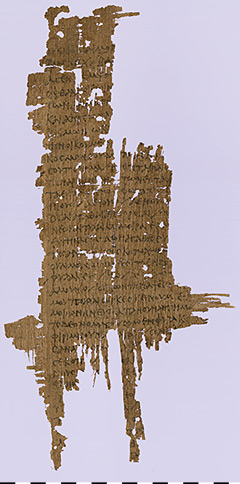PGM XXI (P. 9566 V)
Magic with snakes and frogs? Both appear as parts of magical recipes, whereby the animals are sometimes threatened with a very drastic fate. It is quite different in the papyrus text presented here, in which they appear as divine companions of the deity, whose support is requested for the magic.
The papyrus came into the Berlin Papyrus Collection in 1894 from the private collection of the Berlin publisher and businessman Rudolf Mosse. The texts on both sides are written in Greek. Both texts are only very fragmentarily preserved. On the recto (the front) there are the remains of 39 lines of a process protocol from the Fayum with a clear lower margin. The text can be dated to the 2nd or 3rd century AD on the basis of the writing. The verso (the back) with 34 lines was written a little later and can be dated to the 3rd century AD due to the writing. The text on the back is upside down to the front. An upper margin is clearly visible. The beginnings of the lines can be seen on the left side. The few traces of writing in front of them show that this is not the beginning of the text and a left margin, but only the space between two columns. This observation is confirmed by the fact that the text begins in the first line in the middle of the sentence. We must therefore assume that there must have been at least one other column before the column we received. But probably there were many more, as we know from comparable and better preserved texts with similar content. Thus, only a small part of a role that originally probably contained several columns has been preserved.
From the preserved remains it can be deduced that this is a magical manual. It probably contained several magic instructions (praxeis) and spells (logoi). Only the end of a prayer and the beginning of a spell have been preserved. They belonged to a protective amulet, which is explicitly referred to in line 23. However, since too little of this spell has been preserved, it is no longer possible to say what specific purpose this protective amulet served and what it was intended to protect against. The largest part of the preserved text is dedicated to the invocation to the great God who created the world. He is addressed as Agathos Daimon and is described and appreciated in detail. Most of the descriptions, epithets and aspects of this god, which are mentioned here and originate from Egyptian religious ideas, are also documented in other magical texts. Interesting and very rare, however, is the mention of eight guardians of this great god in lines 19 and 20, which are grouped in four divine pairs: Heh/Hehet (infinity), Kek/Keket (darkness), Nun/Nunet (primordial waters) and Amun/Amunet (concealment). These are personifications of the male and female aspects of the state of the world before creation – the chaos. They are called Ogdoad and are associated with Hermopolis, which in Egyptian is called Chemenu = (city of) the Ogdoad. In Greek, the deities of the Ogdoad are only documented in another magical text. In Egyptian they appear more often, especially with pictorial representations in reliefs, such as in Philae and Dendera. Here the goddesses are represented with snake heads, the gods with frog heads, which also indicates that they are primordial beings. In the present magical text no pictorial representations of the Ogdoad have been inserted, but they are – like other magical words – emphasized by slashes in the running text.
As fragmentary as this text is, the mention of the Ogdoad shows the survival of ancient Egyptian ideas in Roman times and their use for magical purposes.



